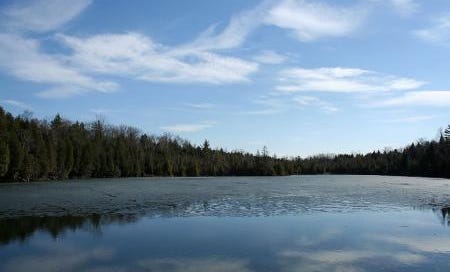Introduction
Recent news reports regarding sediments collected from the floor of Crawford Lake in Ontario, Canada have prompted some within the scientific community to reinforce their wish to officially identify the beginning of a new geological epoch – the Anthropocene. Here is a summary of what identifying the Anthropocene involves.
[You can read a BBC News account of sediments on Lake Crawford here:
The Anthropocene: Canadian lake mud 'symbolic of human changes to Earth' - BBC News]
The geological Quaternary Period began approximately 2.6 million years ago. The Holocene, the most recent subset of the Quaternary, began when the last glacial period ended 11,700 years ago. In 2000 two environmental scientists, Paul Crutzen (a chemist) and Eugene Stoermer (a biologist), first proposed that the Holocene is being replaced by a new phase in Earth’s history. They called the Holocene’s successor the ‘Anthropocene’ because it is the first phase in Earth history where a single species - human beings - is responsible for biophysical changes of such scope and magnitude that they resemble naturally caused alterations that usually take millions of years to occur. Crutzen and Stoermer stated that we have entered ‘the age of humans’ and compared to all previous geological epochs, this stage is entirely ‘unnatural’.
What are the changes?
In the 1990s anthropogenic climate change (aka ‘global warming’) began to be recognised seriously by environmental researchers as a real threat to humans. The 1992 United Nations Earth Summit made the reduction of greenhouse-gas emissions a key issue.
Furthermore, the International Geosphere-Biosphere Programme (IGBP) was created by several countries in the 1990s. It brought environmental scientists together to better understand the connections between some of the changes caused by human activities such as deforestation, urbanisation and even the testing of atomic weapons. Crutzen was one of these scientists. By 2000, leading scientists in the IGBP became concerned that anthropogenic climate change was one part of human induced change to the planet. Their evidence and predictions about the future suggested that humans were altering far more than just the climate of the Holocene.
Crutzen and Stoermer then proposed the term ‘Anthropocene’ as a descriptor for the total human impact on Earth because they believed it would help people recognise how profound that impact is.
Since 2010, the term has become more prominent in academic circles, in popular writing about the Earth, in the news media and in some political arenas. Several scientific groups have referred to the term - including the International Commission on Stratigraphy – and the IGBP has continued to promote the concept. For instance, the Australian climate scientist Will Steffen presented the idea at the Davos meeting of world political and business leaders in 2015.
What does using the term mean?
The term challenges us to rethink the ways we (under)value and (over)utilise the non-human world for our economic goals. Crutzen called for ‘planetary stewardship’ - a global attitude towards Earth that inspires all countries to manage the global environment with much greater care than they currently do. People need to take far less from the natural environment than they currently do and discharge far fewer waste products into it.
Some more radical scientists have stated that the Anthropocene is a huge ‘wake-up call’. Clive Hamilton, an Australian environmentalist, fears that a global environmental catastrophe may be our legacy to our descendants if we do not ‘revolutionise our anti-environmental economic system’ (aka capitalism). Hamilton calls for a new kind of economy (and society) where profit making has no place and where economic activity is only permitted if it’s ecologically friendly. Some Marxist commentators have stated that the end of the Holocene has been caused not so much by Homo sapiens in general but by a small group of wealthy countries and billionaire-humans who benefit from the ongoing destruction of Earth’s life-support systems. Crutzen (Stoermer died in 2010) has argued that humans need to act quickly to avoid environmental thresholds, or tipping points, being crossed, such as a collapse of the Greenland or Antarctic ice sheets, or the failure of the North Atlantic Drift.
Should Geography ‘own’ the term?
The Anthropocene is arguably a geographical phenomenon. Geography is the only academic subject which studies human-environment interactions from the local scale to the global. The Anthropocene is an opportunity for geography to show the value of integrated understanding and synoptic thinking. Geography highlights linkages, consequences, and feedback mechanisms in both physical and human systems. Geographers study variations across space and through time. The concept of Place also helps illustrate how the Anthropocene’s impacts will vary.
Geography really does ‘own’ the term.



